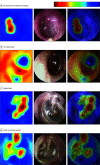A Deep Learning Approach to Predict Conductive Hearing Loss in Patients With Otitis Media With Effusion Using Otoscopic Images
- PMID: 35588049
- PMCID: PMC9121299
- DOI: 10.1001/jamaoto.2022.0900
A Deep Learning Approach to Predict Conductive Hearing Loss in Patients With Otitis Media With Effusion Using Otoscopic Images
Abstract
Importance: Otitis media with effusion (OME) is one of the most common causes of acquired conductive hearing loss (CHL). Persistent hearing loss is associated with poor childhood speech and language development and other adverse consequence. However, to obtain accurate and reliable hearing thresholds largely requires a high degree of cooperation from the patients.
Objective: To predict CHL from otoscopic images using deep learning (DL) techniques and a logistic regression model based on tympanic membrane features.
Design, setting, and participants: A retrospective diagnostic/prognostic study was conducted using 2790 otoscopic images obtained from multiple centers between January 2015 and November 2020. Participants were aged between 4 and 89 years. Of 1239 participants, there were 209 ears from children and adolescents (aged 4-18 years [16.87%]), 804 ears from adults (aged 18-60 years [64.89%]), and 226 ears from older people (aged >60 years, [18.24%]). Overall, 679 ears (54.8%) were from men. The 2790 otoscopic images were randomly assigned into a training set (2232 [80%]), and validation set (558 [20%]). The DL model was developed to predict an average air-bone gap greater than 10 dB. A logistic regression model was also developed based on otoscopic features.
Main outcomes and measures: The performance of the DL model in predicting CHL was measured using the area under the receiver operating curve (AUC), accuracy, and F1 score (a measure of the quality of a classifier, which is the harmonic mean of precision and recall; a higher F1 score means better performance). In addition, these evaluation parameters were compared to results obtained from the logistic regression model and predictions made by three otologists.
Results: The performance of the DL model in predicting CHL showed the AUC of 0.74, accuracy of 81%, and F1 score of 0.89. This was better than the results from the logistic regression model (ie, AUC of 0.60, accuracy of 76%, and F1 score of 0.82), and much improved on the performance of the 3 otologists; accuracy of 16%, 30%, 39%, and F1 scores of 0.09, 0.18, and 0.25, respectively. Furthermore, the DL model took 2.5 seconds to predict from 205 otoscopic images, whereas the 3 otologists spent 633 seconds, 645 seconds, and 692 seconds, respectively.
Conclusions and relevance: The model in this diagnostic/prognostic study provided greater accuracy in prediction of CHL in ears with OME than those obtained from the logistic regression model and otologists. This indicates great potential for the use of artificial intelligence tools to facilitate CHL evaluation when CHL is unable to be measured.
Conflict of interest statement
Figures

Similar articles
-
Automatic Prediction of Conductive Hearing Loss Using Video Pneumatic Otoscopy and Deep Learning Algorithm.Ear Hear. 2022 Sep-Oct 01;43(5):1563-1573. doi: 10.1097/AUD.0000000000001217. Epub 2022 Mar 29. Ear Hear. 2022. PMID: 35344974
-
A deep learning approach to the diagnosis of atelectasis and attic retraction pocket in otitis media with effusion using otoscopic images.Eur Arch Otorhinolaryngol. 2023 Apr;280(4):1621-1627. doi: 10.1007/s00405-022-07632-z. Epub 2022 Oct 13. Eur Arch Otorhinolaryngol. 2023. PMID: 36227348 Free PMC article. Clinical Trial.
-
Conductive Hearing Loss Estimated From Wideband Acoustic Immittance Measurements in Ears With Otitis Media With Effusion.Ear Hear. 2023 Jul-Aug 01;44(4):721-731. doi: 10.1097/AUD.0000000000001317. Epub 2022 Dec 29. Ear Hear. 2023. PMID: 36607739 Free PMC article.
-
Medical management of middle ear disease in children less than 2 years of age with sensorineural hearing loss.J Otolaryngol. 2005 Aug;34 Suppl 2:S64-9. J Otolaryngol. 2005. PMID: 16076419 Review.
-
Management of Conductive Hearing Loss in Children.Otolaryngol Clin North Am. 2015 Dec;48(6):955-74. doi: 10.1016/j.otc.2015.06.007. Epub 2015 Sep 8. Otolaryngol Clin North Am. 2015. PMID: 26360369 Review.
Cited by
-
Diagnosis, Treatment, and Management of Otitis Media with Artificial Intelligence.Diagnostics (Basel). 2023 Jul 7;13(13):2309. doi: 10.3390/diagnostics13132309. Diagnostics (Basel). 2023. PMID: 37443702 Free PMC article. Review.
-
Evaluating Prediction Models with Hearing Handicap Inventory for the Elderly in Chronic Otitis Media Patients.Diagnostics (Basel). 2024 Sep 10;14(18):2000. doi: 10.3390/diagnostics14182000. Diagnostics (Basel). 2024. PMID: 39335679 Free PMC article.
-
Artificial Intelligence in Audiology: A Scoping Review of Current Applications and Future Directions.Sensors (Basel). 2024 Nov 6;24(22):7126. doi: 10.3390/s24227126. Sensors (Basel). 2024. PMID: 39598904 Free PMC article.
-
Deep Learning Techniques and Imaging in Otorhinolaryngology-A State-of-the-Art Review.J Clin Med. 2023 Nov 8;12(22):6973. doi: 10.3390/jcm12226973. J Clin Med. 2023. PMID: 38002588 Free PMC article. Review.
-
Intelligent imaging technology applications in multidisciplinary hospitals.Chin Med J (Engl). 2024 Dec 20;137(24):3083-3092. doi: 10.1097/CM9.0000000000003436. Epub 2024 Dec 18. Chin Med J (Engl). 2024. PMID: 39690448 Free PMC article. Review.
References
-
- Tos M. Epidemiology and natural history of secretory otitis. Am J Otol. 1984;5(6):459-462. - PubMed
-
- Williamson IG, Dunleavey J, Bain J, Robinson D. The natural history of otitis media with effusion--a three-year study of the incidence and prevalence of abnormal tympanograms in four South West Hampshire infant and first schools. J Laryngol Otol. 1994;108(11):930-934. - PubMed
Publication types
MeSH terms
LinkOut - more resources
Full Text Sources
Medical
Miscellaneous

